“At night, after hours, in good weather, and even when the weather is not so good, people gather around the library to try and get on Wi-Fi leaking through the doors,” Linda Johnson, president of the Brooklyn Public Library told me a few days ago. While the Trump administration—especially the Federal Communications Commission (FCC)—preaches about its commitment to close the digital divide, they have done little to help the largest component of that divide: low-income Americans such as those on the library steps. Instead, the Trump FCC’s efforts have focused on Donald Trump’s base of rural voters.
With typical Trumpian fanfare, the Chairman of the FCC has frequently and fervently proclaimed his top priority is ending the digital divide. “Since my first day as Chairman of the FCC, my number one priority has been closing the digital divide and bringing the benefits of the internet age to all Americans,” Trump’s FCC Chairman Ajit Pai proclaims on a slickly produced FCC web page. Accompanying that pledge is a list of “Key Initiatives” of the Chairman’s—all of which are directed at rural areas.
Donald Trump won 62 percent of the national rural vote. But that’s not where the biggest broadband problem lies. There are almost three times as many Americans without a broadband subscription in blue urban areas than in red state rural areas.
Two Parts of the Digital Divide: Adoption vs. Access
The Trump FCC, by focusing its attention on rural areas with a lack of access (i.e., those unable to get broadband) is dealing with only part of the digital divide. The larger part of the digital divide is adoption; those Americans who may have broadband available, but don’t or can’t use it. According to data assembled by the Government Accountability Office (GAO), the most important reason why the available broadband isn’t used is “can’t afford.”
Billions of dollars have been given to corporations that refuse to extend broadband connections without such welfare. Yet, the Trump FCC has done little to help low-income Americans—urban or rural—bring the internet into homes already passed by broadband.
This dichotomy becomes particularly pernicious as America goes back to school in a pandemic. Having to sit on the steps of the library after hours or go to McDonald’s to get on the internet for school is not an acceptable education strategy.
The Trump FCC’s inattention falls heaviest on blue state low-income Americans. The Joint Center for Political and Economic Studies reports that “30.6% of Black households with one or more children 17 or younger lack high-speed home internet (over 3.25 million Black children live in these households).” When the pandemic shut down schools, for instance, approximately 90 percent of the 51,000 students in the predominantly African American Detroit Public Schools Community District could not access the internet.
It is not just schoolwork that is affected by the lack of action on urban internet connectivity. It is virtually impossible to get a job without an internet connection to both search and apply for that job. Led by Rep. James Clyburn (D- SC), the House of Representatives has twice this year passed legislation to fund a $50 per month emergency credit for low-income Americans to obtain broadband connectivity. The HEROES Act and Moving Forward Act have both died in the Republican-controlled Senate.
For years the FCC has struggled to develop a response to this poor connectivity, largely because the existing federal program was designed around telephone service rather than internet service. Working inside those restrictions, the Obama FCC took two steps to try and expand low-income connectivity. First, it established a one-stop federal approval process for firms to participate in the low-income support program (called Lifeline) rather than an arduous state-by-state process. Second, the Obama FCC expanded the Lifeline-supported use of mobile networks for internet access. The Trump FCC repealed the first and gutted the second by proposing to deny participation to those companies specializing in pre-paid services for low-income Americans.
Time to Show Top Priority
The COVID-19 pandemic provides an opportunity for the FCC to break the legacy policy logjam. A national emergency justifies emergency actions. Here are three solutions the Trump FCC could pursue if they really were dedicated to making the digital divide their “number one priority.”
Spend E-Rate Surplus to Connect the New “Classrooms”
Thanks to Obama-era reforms, the FCC’s E-Rate program has enabled over 95 percent of all school campuses to connect to the internet all the way to the students’ desks. These reforms also resulted in program costs going down while coverage went up. As a result, by one estimate, there is now approximately $2 billion sitting unspent in the E-Rate program.
The pandemic has moved the “classroom” to the living room and kitchen. The unspent E-Rate funds should be redirected on an emergency basis to help low-income students connect with their teachers.
As Colorado Attorney General Phil Weiser recently pointed out in a petition to the FCC, Congress explicitly gave the agency “specific authority to alter the definition [of services] to provide a different definition for schools…”[1] If the Trump FCC wanted to it could use its general powers to ensure universal service by opening E-Rate funds for out-of-school use. Even if it was unwilling to do that, the agency could identify, on a temporary basis, that pandemic classrooms included student homes, thus qualifying low-income Americans for E-Rate support enabling them to purchase the internet service that already runs by their doors.
Make Cable Companies Eligible for Lifeline
To be eligible for the Lifeline low-income support program an internet service provider must be an “Eligible Telecommunications Carrier” (ETC). Basically, this favors telephone companies, which are already ETCs, and therefore eligible for Lifeline support. This is a legacy from when the Reagan administration created Lifeline as a subsidy for telephone service in low-income households—long before anyone had heard of the internet.
Today, however, it is cable companies, not telephone companies, that are the principal providers of high-speed broadband service. The cable companies have acted responsibly to create a minimum-tier, reduced-price program for low-income Americans. Comcast’s low-tier “Internet Essentials” offering, for instance, is $9.95 per month. But because cable companies generally are not ETC’s, we are missing a huge opportunity to support the responsible actions of the cable companies.
President Trump has described himself as a “wartime president.” Under such emergency “wartime” conditions, one would expect the FCC would be looking for ways to combine Lifeline dollars with programs such as Internet Essentials to actually address the problem of people lacking access to broadband because of a red tape definition.
Repeat What the FCC Has Already Done for a Favored Constituency
In July, Trump-appointed FCC Commissioner Brendan Carr proposed creation of a new health care support program for rural residents. The Commission adopted the proposal in August—lightning fast action for the agency.
Commissioner Carr’s proposal modified an existing program designed to support rural healthcare facilities to support rural individuals. It is an excellent initiative.
Like the Trump FCC’s other efforts, however, the new initiative focused on the rural constituency of Trump voters. Yet in doing so, Commissioner Carr created the model for how the FCC could also deal with the needs of low-income Americans. If the Trump FCC were serious about overcoming the educational digital divide, it could similarly modify the E-Rate program to move from supporting services to buildings housing schools and libraries and allow support of services to individuals.
A 21st Century Civil Right
Amidst the overriding national challenges of racial equality, a poorly managed pandemic, and economic upheaval it is legitimate to ask whether broadband for all Americans rises to the level of a national priority.
The huge challenges faced by the United States represent the metastasis of multiple issues. As is true of all great battles, the outcome will be determined by the results of smaller skirmishes dealing with those parts. In the great battle for social equality, a healthy population, and a growing economy, one of those skirmishes is whether and how we finally come to grips with the provision of the high-speed broadband connectivity for equality, opportunity and education.
For sure, rural broadband is a national deficiency failing that must be overcome. The Trump FCC, however, has politicized the programs created to attack the digital divide. Targeting effort to help the base of rural Trump voters while largely turning a blind eye to the plight of blue state low-income Americans is hardly the promised “bringing the internet to all Americans.”
Shortly before he died, civil rights leader and congressman John Lewis (D-GA) explained in an interview, “Access to the internet…is the civil rights issue of the 21st century.” It is time to move forward on that right—for all Americans.
[1] 47 U.S.C. §254(c)(3)
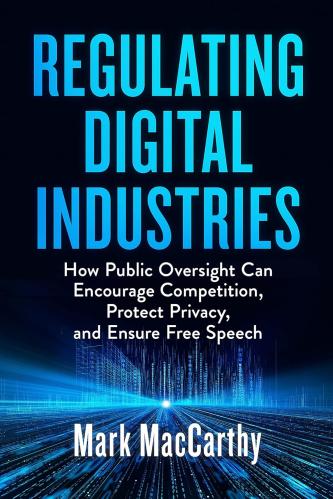
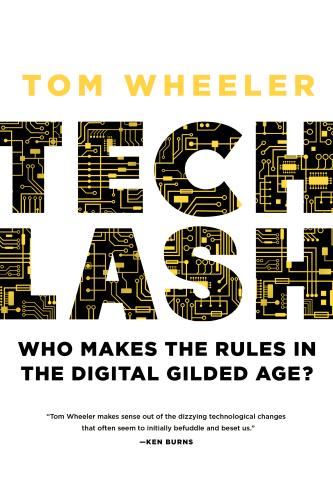

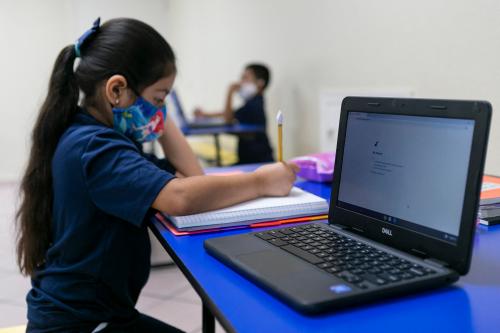
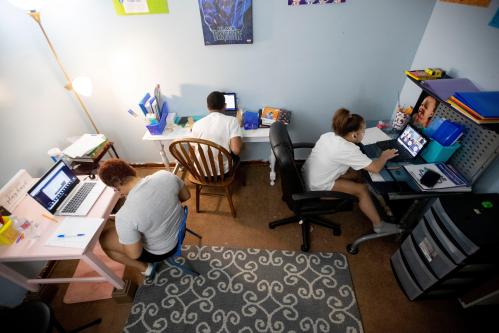
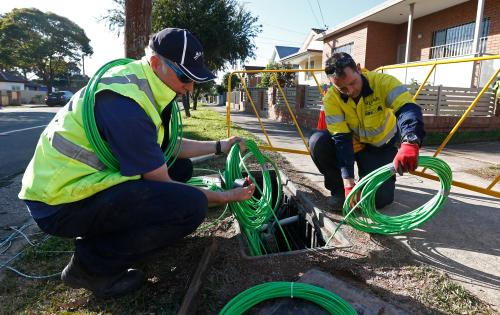




Commentary
Broadband in red and blue states: Three solutions to low-income internet access
September 9, 2020